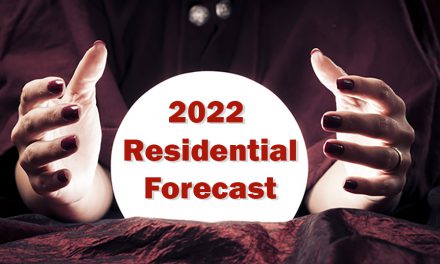Setting the appointment is an opportunity to set your customers’ expectations
for how you would like them to be engaged in the call process. It can separate
you from other contractors even before the call is made
Have you ever run a call where the customer opened the door and instructed you to go around the house to look at the condenser? Have you arrived on time and another contractor was there? Have you started your call by explaining your process and they told you they only had 20 minutes?

Tom Piscitelli
You have likely had these situations and worse. Some companies have sales call no-shows up to 5% of all of their leads. If their lead cost is $300, and the salesman runs 400 leads a year, that means 20 weren’t home, costing the company $6,000 net profit dollars. Even worse, those 20 leads, properly set, with a 50% close rate and $8,000 average sale, meant a company had an opportunity cost of $80,000 in lost sales or $30-40,000 in lost gross profit dollars. This example is for only one salesperson.
Let’s not forget how the salesperson is affected. No show customers impact the salesperson’s drive time, customer calling time, office calling time, wait-around time and so on. This is very frustrating. The lost commissions, well, that’s not a good story either.
The Importance of Setting Appointments Properly
No-shows are part of the story. Even more important is how all appointments are set. Making appointments in the right manner has the potential to improve the close rate and job selling prices. Think about this: by improving close rates by 5% and average job prices by only $1,000 on 400 leads, you can increase annual sales by $300,000.
To do that the salesperson must take more time and conduct a more professional call, showing customers what is substandard in their system and explaining the negative impact of not addressing fundamental design and/or installation problems. When the customer service representative (CSR) sets the stage for this kind of call, the salesperson is more likely to have receptive customers.
Setting the appointment is typically something that is not prescribed or managed by the owners. It’s well worth the time it takes to get this done and to make sure it continues to get done. Let’s take a look at how you can improve the level and quality of customer engagement on every call to produce more sales.
First, Decide What Your In-Home Sales Call Process Is
If you don’t have one in writing, this has to be done or your CSR can’t explain it to your customers. See my July article for details (ncilink.com/SalesProcess).
What Do You Want Your CSR’s to Say? What is said, when it is said, and how it is said are all important. I’ve made many ride-along coaching calls where the homeowner was clearly surprised at what the salesperson said they were going to do and responded defensively, suspecting the salesperson had some alternative agenda.
The owner, salesperson, and everyone who sets the appointment should be involved in the appointment-setting plan. I’m a proponent of scripting things like this because various people might be setting the appointment and new people will need to be trained.
Here’s a sample script of how this might be done:

Setting the sales appointment is the first, key step, in differentiating your contracting firm from the pack
Sample Script 1
CSR: Good Morning, thank you for calling Our Company, my name is ___, how may I help you today?
Customer: I’d like to have someone come out and give me an estimate for a new furnace/air conditioner/heat pump/boiler/water heater.
CSR: Great I’ll be glad to help you. Let me gather your information and then I have a few questions for you so our comfort advisor will be prepared. This will take about 10 minutes, is that okay?
So, may I begin with your address, please? (The CSR gathers the customer’s information)
CSR: May I ask if you have ever replaced your furnace or air conditioner before?
CSR: Okay, thanks, may I ask why you’ve decided to replace your system now?
Sample Script 2
CSR: What time frame did you have in mind for completing this project?
CSR: If you have just a few more minutes, I’d appreciate the opportunity to describe what our in-home consultative process will be.
CSR: Our technician will start by asking you some questions, then ask you permission to do a brief survey of your home. During that time, he’ll take some measurements to determine if your ductwork has adequate capacity and you have properly sized equipment. After that, he will be prepared to show you some choices to consider. All this will take from 60-90 minutes depending on your questions. He’ll stay as long as you wish.
CSR: I have an opening ______?’ or ________. Would one of those dates be good for you (both) or should we find another time?
In these examples we established some important things:
- The CSR asked permission to gather important information
- We know if they have ever had a system replaced
- We know why this is important now ‘ or not so urgent if that is the case
- The customer now expects the salesperson to inspect the ductwork as well as the equipment
- We set an expectation for a 60-90 minute or longer call.
Contrast this with how your appointments are currently set. I’m pretty sure there isn’t much more discussed other than picking a convenient time. If that’s the case, then you are just like everyone else coming out to give a bid, estimate, or quote. Yuk.
One-Legger Vs. Two-Legger Appointments
For those new to sales, these terms refer to calls where the potential customer is either one person in a couple or both. A ‘couple’ can be husband and wife, single-parent and friend, daughter-homeowner and father, or any combination of decision-makers and others who are counted on by the owner for input.
 In the past, it had been very common for the CSRs to insist ‘both decision-makers be present’ to schedule an appointment. This was very common in many in-home sales industries. The reason is clear; when both ‘decision-makers’ are present, the likelihood of making the sale on the first call is higher.
In the past, it had been very common for the CSRs to insist ‘both decision-makers be present’ to schedule an appointment. This was very common in many in-home sales industries. The reason is clear; when both ‘decision-makers’ are present, the likelihood of making the sale on the first call is higher.
As consumers have become educated to this tactic, they have pushed back. The cautious homeowner will purposefully have one person there so they can gather information on the first call and then make their decision later, without a ‘pushy’ salesperson lingering at the kitchen table and often refusing to leave until the sale is made.
Our industry is built on customer satisfaction and the resulting loyalty that produces repeat service, maintenance, replacement, and referral business. A single sale might be $10,000 but the lifetime revenue could be twice or three times that. If we use abrasive selling techniques to make the immediate sale, a negative reputation would be the result and word would spread in the community.
In today’s world, where consumer ratings are so common, a single negative consumer rating can have a lasting impact on the company’s business.
What Can You Do?
As always, your CSR can simply tell the truth. Here is some language that has been time-tested, will improve your two-legger appointments, and increase your first-call close rates:
CSR: Thank you. One more thing. Most folks aren’t aware that nine out of 10 existing systems are incorrectly designed or installed. Usually, the equipment is oversized, shortening its life. Or the ductwork is inadequate or too leaky causing higher energy bills.
There are often hot and cold spots in the home as well as health issues for the family and more. This is a big decision that impacts your entire family.
Once you invest, the system typically lasts 15 or 20 years, so you live with it for a long time. Is there anyone you might want to invite to join you who may also have questions?
The final question, ‘Is there anyone else you might want to invite?’, following an explanation of the reason for it, will be heard by the customer who isn’t so confident in his or her ability to gather the information needed to make the decision. I’d encourage you to consider scripting this language and coaching your CSR’s to say it verbatim. It works.
Confirmation and Agreement
This appointment setting process can take up to 10 minutes if customers are willing, or less if they’re not. Either way, the CSR should summarize what was agreed to with an emphasis on their engagement in the call. The CSR can end the call by summarizing the key points:
CSR: Okay, great. So, Tom will be there this Thursday at 5:00 PM. He will ask you and anyone you might invite to the meeting what you want in a new system. He will survey your home with you if you can join him. Furthermore, he will go into the attic or crawl space to inspect the ductwork and equipment and take some important measurements. He will then share all of this with you. After that, he will prepare some choices for you to consider. All of that will take 60-90 minutes. Does that sound right to you?
This final statement essentially repeats what was said earlier, intending to reinforce the salesperson’s activities and the customer’s time commitment. Often, when this is well done, the customer will be impressed with this professionalism and decide not to call other contractors. At the least, if they do call others, your appointment-setting call will stand above the others in many positive ways.
Finally, the Email Confirmation
These days, most of us are accustomed to email notices, reminders, and calendar invites. Your CSR should offer to send an email confirmation. Customers appreciate that. In the email, include the same language we’ve already discussed, along with some information about and a photo of the salesperson.
Setting the appointment is the first part of the sales process and it represents an important opportunity to differentiate your company before the salesperson even knocks on their door.’
Tom Piscitelli has more than 40 years’ experience in HVAC sales, sales management, marketing, and consulting. His articles have been published in trade magazines, he often speaks at industry events, he has produced three HVAC sales training DVD’s, and he particularly enjoys bringing cutting edge training approaches to our industry (www.sellingtrust.com). His most recent project has been co-authoring and publishing the book, Proposition Selling: How to Create Extraordinary Success in Business-to-Business Sales (www.propositionselling.com).












Recent Comments